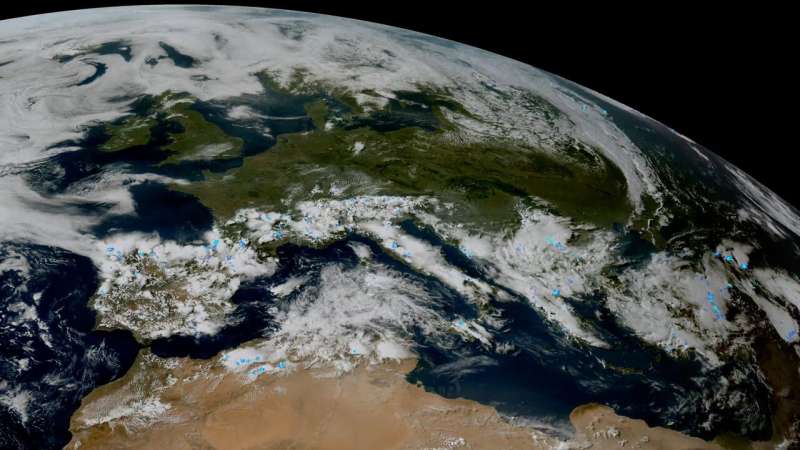This article has been reviewed according to Science X's editorial process and policies. Editors have highlighted the following attributes while ensuring the content's credibility:
fact-checked
proofread
A forecasting revolution on its way through new satellite data

As the calibration and validation of the various elements of the spacecraft and ground segment progresses, data captured by the two main instruments on board MTG-I1, the Flexible Combined Imager (FCI) and the Lightning Imager (LI), were combined for the first time to highlight their synergies. This first set of animations gives us a preview of the system's future impact.
"These animations demonstrate how the combination of the two instruments will revolutionize nowcasting and the monitoring of severe thunderstorms," explains Phil Evans, director-general, EUMETSAT. "I am extremely impressed and am looking forward to the innovative applications that will stem from these data after they become operational."
The high-resolution visible and infrared channels of FCI allow the precise observation and characterization of clouds and thunderstorms during the day and night, while the LI instrument detects lightning activity as an indicator of strong atmospheric turbulence and convection.
When fully operational, MTG-I1 will empower meteorologists and scientists to monitor extreme weather events with unprecedented accuracy. The new and more precise data will also enable numerical weather prediction models to be even more accurate, thus increasing the reliability of early warnings for extreme weather events and their ability to protect lives and property.
"The European cooperation on satellite data is crucial for the SMHI and we look forward to following the operationalization of the MTG-I1. A forecaster always relies deeply on information from weather observations, especially in situations with rapidly evolving and extreme weather events. The information has to be accurate and with high resolution to capture local phenomena, something the MTG-I1 will be able to provide," says Håkan Wirtén, Director General, SMHI.
Storm Hans recently swept through Sweden, Denmark, Estonia, Finland, Latvia, Lithuania, and Norway, causing extreme rainfall, deadly landslides, extensive flooding, and generally putting the lives and livelihoods of entire regions at risk.
The MTG-I1 animation with storm Hans shows how hot and moist air from southern Europe hit the cooler air in Scandinavia, resulting in massive thunderstorms. As the flow of energy and humidity continued, the storm lasted several days with heavy rains and strong winds.
Such extreme weather events are likely to become increasingly frequent as the Earth's climate keeps changing. Freely accessible, timely and high-resolution global Earth observation data, such as those distributed daily by EUMETSAT, will play an increasingly important role in how we protect our populations from such risks.
MTG-I1 was launched on 13 December 2022. It is operated by EUMETSAT from its headquarters in Darmstadt, Germany. The satellite was procured by ESA, fulfilling the requirements established by EUMETSAT in consultation with the meteorological services in its member states. Thales Alenia Space (France), MTG prime contractor, built the imaging instrument, the Flexible Combined Imager, and integrated it onto the MTG-I1 satellite, for which OHB (Germany) supplied the platform. The Lightning Imager was developed by Leonardo (Italy).
Provided by European Organisation for the Exploitation of Meteorological Satellites (EUMETSAT)





















